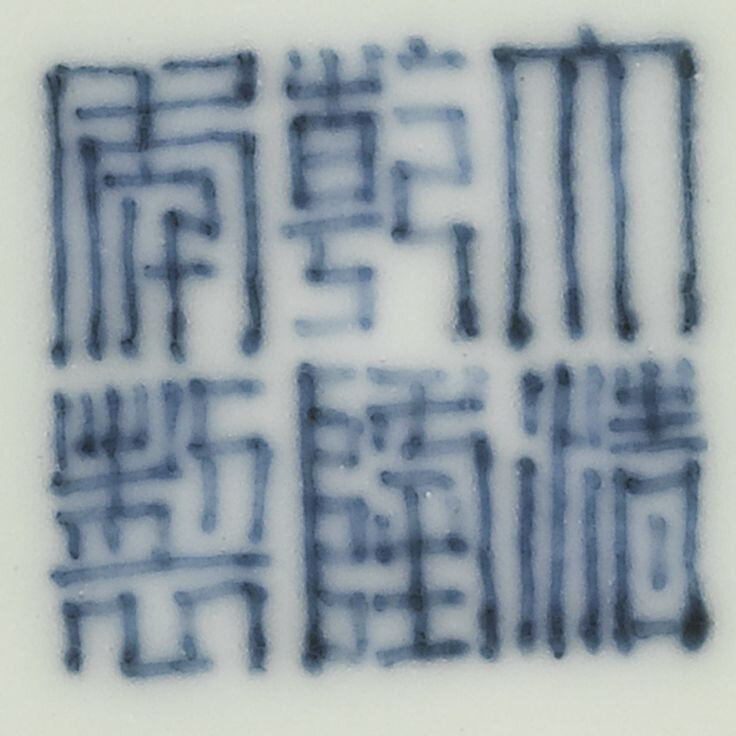A fine and rare small celadon-glazed archaistic mallet vase, Seal mark and period of Qianlong
Lot 3619. A fine and rare small celadon-glazed archaistic mallet vase, Seal mark and period of Qianlong (1736-1795); 9.8 cm., 3 7/8 in. Estimate 200,000 — 400,000 HKD. Lot sold 3,400,000 HKD. Photo Sotheby’s
the slightly flared sides below a sharply angled shoulder, columnar neck and flattened rim, finely carved and decorated in white slip with a band of three asymmetrical archaistic kui-dragon panels, below a band of S-keyfret and detached stylized zoomorphs on the shoulder, all separated by borders of tiny studs, the neck with a collar of upright lappets and further stud and S-keyfret bands, applied overall with a fine pale bluish-green glaze draining to a paler tone over the carving, the base inscribed in underglaze blue with a six-character reign mark; 9.8 cm., 3 7/8 in.
Provenance: An East Coast private collection.
Sotheby’s New York, 17th October 2001, lot 155.
Note: Qianlong vases of this form are extremely rare and this piece is particularly notable for the delicate asymmetrical dragon design that encircles the body; its companion piece is in the Walters Art Museum, Baltimore, acc. no. 49.1314. In form and decoration it closely follows a Yongzheng prototype, but with slight variations in the decorative bands encircling the neck, as seen on a lime-green glazed vase sold in these rooms, 11th April 2008, lot 2910.
Monochrome celadon-glaze porcelains with delicate relief designs were one of the specialities of the imperial kilns during the Yongzheng reign and continued to develop in the Qianlong period on vessels with bolder designs. The celadon glaze seen on this piece, generally employed for vases with relief decoration, is of bright sea-green tone known as douqing (bean-green), and represents the remarkable achievement of potters whose refined and innovative approach to colours and glazes, combined with attractive decorations, made the creation of such elegant pieces possible. To achieve the subtle effect of the tonal variations of the glaze on areas in relief against the flat surface, flawless and uniform firing of the utmost perfection was required. Particular innovation was required in creating a celadon glaze that captured the depth of colour on a white porcelain body rather than the grey body of the Song original.
The unusual shape of this vase is reminiscent of the finest Longquan celadon mallet vases of the Song period (960-1279). The most exquisite Longquan wares were produced during the Southern Song period and characteristically have a bluish-green colouration. Due to the thickness and opacity of the glaze, a result of the thousands of tiny bubbles and particle inclusions, Longquan celadons were generally left undecorated. Hence the appeal relied on the aesthetics of the form and quality of glaze. It was only in the Yuan dynasty that moulded and carved decoration was introduced which initiated a significant change in the decorative direction of Longquan wares. See a mallet-shaped Longquan celadon vase, from the Qing Court collection and still in Beijing, illustrated in The Complete Collection of Treasures on the Palace Museum. Porcelain of the Song Dynasty (II), Hong Kong, 1996, pl. 100; and another, from the Hachisuka Family, Nobuo Komuro, Fuyuki Tominaga and Takashi Masuda collections, sold in our London rooms, 8th November 2006, lot 56.
Sotheby’s. Fine Chinese Ceramics and Works of Art. Hong Kong, 08 oct. 2014

/https%3A%2F%2Fprofilepics.canalblog.com%2Fprofilepics%2F1%2F0%2F100183.jpg)
/https%3A%2F%2Fstorage.canalblog.com%2F03%2F02%2F119589%2F96711876_o.jpg)
/https%3A%2F%2Fstorage.canalblog.com%2F11%2F31%2F119589%2F94773502_o.jpg)
/https%3A%2F%2Fstorage.canalblog.com%2F20%2F83%2F119589%2F94772815_o.jpg)
/https%3A%2F%2Fstorage.canalblog.com%2F26%2F72%2F119589%2F75604929_o.jpg)
/https%3A%2F%2Fstorage.canalblog.com%2F59%2F60%2F119589%2F26458628_o.jpg)




/image%2F1371349%2F20240402%2Fob_7227e1_129-1.jpg)
/image%2F1371349%2F20240329%2Fob_2076ee_113-1.jpg)
/http%3A%2F%2Fstorage.canalblog.com%2F92%2F58%2F119589%2F129772574_o.jpg)
/http%3A%2F%2Fstorage.canalblog.com%2F50%2F04%2F119589%2F129632031_o.jpg)